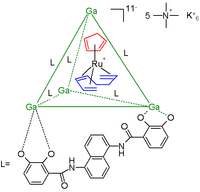- Molecular encapsulation
-
 Molecular encapsulation of a nitrobenzene bound within a hemicarcerand reported by Cram and coworkers in Chem. Commun., 1997, 1303-1304.
Molecular encapsulation of a nitrobenzene bound within a hemicarcerand reported by Cram and coworkers in Chem. Commun., 1997, 1303-1304.
Molecular encapsulation in supramolecular chemistry is the confinement of a guest molecule inside the cavity of a supramolecular host molecule (molecular capsule, molecular container or cage compounds). Examples of supramolecular host molecule include carcerands and endohedral fullerenes.
Contents
Reactivity of guests
An important implication of encapsulating a molecule at this level is that the guest is prevented from contacting other molecules that it might otherwise react with. Thus the encapsulated molecule behaves very differently from the way it would when in solution. The guest molecule tends to be extremely unreactive and often has much different spectroscopic signatures. Compounds normally highly unstable in solution, such as arynes or cycloheptatetraene have been successfully isolated at room temperature when molecularly encapsulated.
Examples
One of the first examples of encapsulating a structure at the molecular level was demonstrated by Cram and coworkers [1] in which they were able to isolate highly unstable, antiaromatic cylobutadiene at room temperature by encapsulating it within a hemicarcerand. Isolation of cyclobutadiene allowed chemists to experimentally confirm one of the most fundamental predictions of the rules of aromaticity.
In another example [2] the cage consists of a gallium tetrahedral cluster compound stabilized by 6 bidentate catechol amide ligands residing at the tetrahedron edges. The guest is a 16 electron and thus very reactive ruthenium metallocene (a organometallic catalyst) with a cyclopentadienyl ligand (red) and a 1,3,7-octatriene ligand (blue). The total charge for this anion is 11 and the counterions are 5 tetramethyl ammonium cations and 6 potassium cations. The ruthenium compound decomposes in water within minutes but encapsulated it survives in water for weeks.
Other applications:
- the encapsulation of filaments of a self-assembling bi-copper complex in polymer nanowires.
See also
References
- ^ Cram, D. J.; Tanner, M. E.; Thomas, R., The taming of Cyclobutadiene Angewandte Chemie International Edition Volume 30, Issue 8 , Pages 1024 - 1027 1991 Abstract
- ^ Stabilization of Reactive Organometallic Intermediates Inside a Self-Assembled Nanoscale Host Dorothea Fiedler, Robert G. Bergman, Kenneth N. Raymond Angewandte Chemie International Edition Volume 45, Issue 5 , Pages 745 - 748 2006 Abstract
Categories:
Wikimedia Foundation. 2010.

